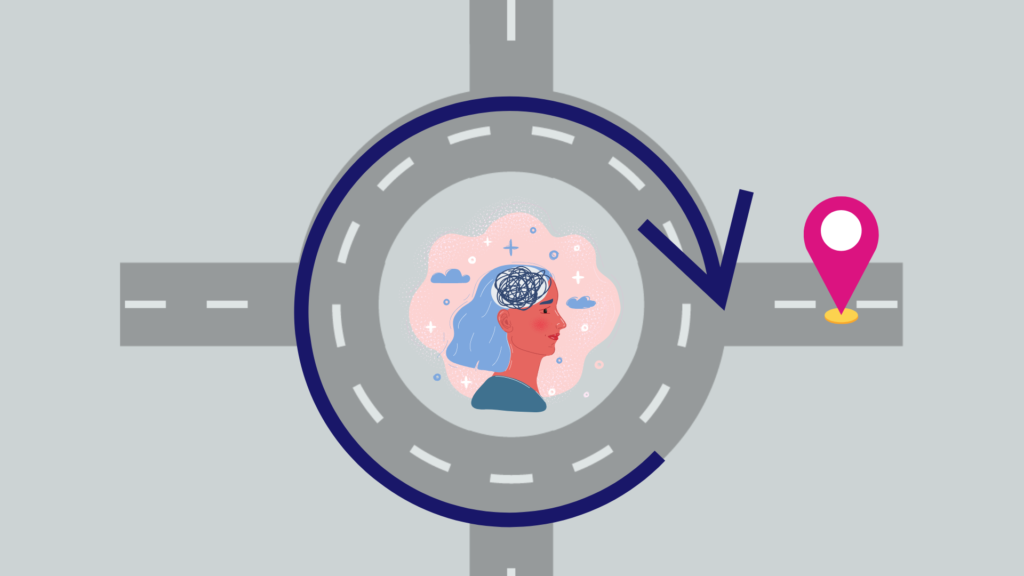Why Anxiety and Depression Love Company

A significant proportion of people experiencing anxiety will also experience depression. There are a number of reasons why so many people experience depression and anxiety at once. A key explanation is that similar processes drive and maintain both anxiety and depression.
More specifically, both anxiety and depression are driven by the interaction between thoughts, feelings and behaviours. The same thoughts, behaviours and physical sensations that underlie anxiety can also contribute to feelings of depression.
For example, someone who experiences thoughts like “other people think I’m incompetent” or “other people won’t like me” may, in turn, experience feelings of depressed mood, and anxiety in social situations.
These anxious feelings might then lead them to engage in the behaviour of avoiding social situations. This behaviour maintains the feeling of anxiety as the person does not have the opportunity to learn that their anxious thoughts are not true, leading them to be trapped in a vicious cycle of anxiety and depression.
[Mood] swings and roundabouts

Withdrawing from social situations can also maintain feelings of depression due to a lack of activities and connection with others. This can lead to getting stuck in a pattern known as the lethargy cycle, where negative thoughts about oneself lead to low motivation, causing withdrawal from activities. This in turn creates more negative thoughts, and thus the cycle continues.
When worries and anxiety persist for long enough, it can be hard not to feel down as a result. Similarly, when feelings of low mood and sadness linger, this can contribute to worries about the future.
Thankfully, the skills to help reduce anxiety and depression are similar. There is a way forward if you find yourself caught in feelings of worry and sadness.

Build a road out of the cycle of anxiety and depression
Stepping off the vicious cycle, or ‘roundabout’, of anxiety and depression involves doing things differently. A helpful place to start is with a new behaviour. Pick an activity that gives you a sense of fun, interest, joy or achievement, or an activity that you have avoided due to fear or anxiety.
Even if you don’t feel like it, it’s important to follow through with the activity and be curious to see how you feel afterwards. This helps to break the cycle that maintains both anxiety and depression.
For example, you may wish to:
- Listen to your favourite song > can lead to thoughts such as “I forgot how much I like this music, it reminds me of when I went the band’s concert last year and had a great night” > increased motivation to listen to more music
- Go for a short morning walk > can lead to thoughts such as “Initially I didn’t feel like getting out of bed, but after going for a walk I feel more calm and relaxed for the day ahead” > can lead to improved mood and reduces physical anxiety symptoms
- Call a friend > can lead to thoughts such as “Before I called them I was worried they would not want to chat. We ended up having a great catch-up, and made plans together for the weekend” > can lead to more balanced thoughts and reduce anxiety
- Start a task you’ve been putting off > “I have been procrastinating starting my assignment because it felt overwhelming, though once I got started and broke down the task it wasn’t as bad as I had expected” > can reduce worry and rumination
For ideas on other things to do to improve your mood and reduce anxiety, take a look at our ‘150 Things to Do’ list.
To help you fill your toolbox of strategies to combat both anxiety and depression, check out our Mixed Anxiety and Depression programs.
Not Sure which program is for you?
Take a Test to Help You Choose a Program
If you’re unsure which program to pick, take our anonymous online test to check how you feel and see which program may be suitable. This test will show you your levels of stress, anxiety, or depression and will make suggestions on what you can do next.




